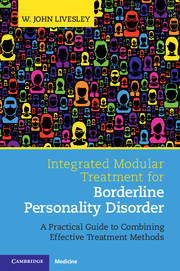 Integrated Modular Treatment for Borderline Personality Disorder
Integrated Modular Treatment for Borderline Personality Disorder Book contents
- Frontmatter
- Dedication
- Contents
- Preface
- Section 1 Introduction and Framework for Understanding Borderline Personality Disorder
- 1 Introduction
- 2 Understanding Normal and Disordered Personality
- 3 Understanding Borderline Personality Disorder
- 4 Origins and Development
- Section 2 Assessment and Treatment Planning
- Section 3 General Treatment Modules
- Section 4 Safety, Containment, and Engagement: The Initial Phase of Treatment
- Section 5 Improving Emotional Regulation and Modulation
- Section 6 Exploration and Change: Treating Interpersonal Problems
- Section 7 Constructing an Adaptive Sense of Self
- Section 8 Retrospect and Prospect
- References
- Index
4 - Origins and Development
from Section 1 - Introduction and Framework for Understanding Borderline Personality Disorder
Published online by Cambridge University Press: 16 February 2017
- Frontmatter
- Dedication
- Contents
- Preface
- Section 1 Introduction and Framework for Understanding Borderline Personality Disorder
- 1 Introduction
- 2 Understanding Normal and Disordered Personality
- 3 Understanding Borderline Personality Disorder
- 4 Origins and Development
- Section 2 Assessment and Treatment Planning
- Section 3 General Treatment Modules
- Section 4 Safety, Containment, and Engagement: The Initial Phase of Treatment
- Section 5 Improving Emotional Regulation and Modulation
- Section 6 Exploration and Change: Treating Interpersonal Problems
- Section 7 Constructing an Adaptive Sense of Self
- Section 8 Retrospect and Prospect
- References
- Index
Summary
This chapter is not intended to provide a detailed exposition of the many risk factors for borderline personality disorder (BPD). Instead, it provides a broad overview of how aetiological and developmental factors shape both borderline pathology and treatment strategies.
General Conclusions
Although knowledge of the aetiology and development of BPD remains rudimentary, some general conclusions are clear. First, the disorder arises from the interplay of multiple genetic and environmental influences. Second, individual risk factors have only a small effect: disorder arises from the accumulative effects of multiple factors. Both conclusions differ radically from earlier assumptions that BPD was largely caused by psychosocial adversity, especially childhood sexual abuse. However, BPD does not have a single “big cause,” which needs to be kept in mind when assessing and treating patients to avoid a pointless search for major “causes.”
Third, the disorder develops along multiple pathways so that the combination of factors giving rise to BPD differs substantially across cases. Some cases arise from an array of genetic and environmental factors. With others, genetic factors appear to predominate: it is relatively common to encounter patients with no history of severe adversity. In such cases, family members often report that the child had a “difficult temperament” from birth and was anxious and emotionally reactive from an early age. Other patients, however, have a history of such severe adversity that a high level of genetic predisposition is probably not necessary for the disorder to emerge. However, even with these cases, genetic factors probably play a role because not all individuals who experience extreme adversity develop psychopathology.
Genetic Influences
Studies of twins show that genes and environment contribute approximately equally to the variability in BPD. The amount of variability in a personality phenotype explained by genetic influences is referred to as heritability. Heritability estimates for BPD range from about 40 per cent to 70 per cent. The different estimates are probably due to differences in sample size: a large sample is required to give stable estimates. Large-scale studies of borderline traits report heritabilities in the 40–55 per cent range. Since these estimates are similar to values reported for other personality traits, we can be reasonably confident about them.
- Type
- Chapter
- Information
- Integrated Modular Treatment for Borderline Personality DisorderA Practical Guide to Combining Effective Treatment Methods, pp. 39 - 48Publisher: Cambridge University PressPrint publication year: 2017


